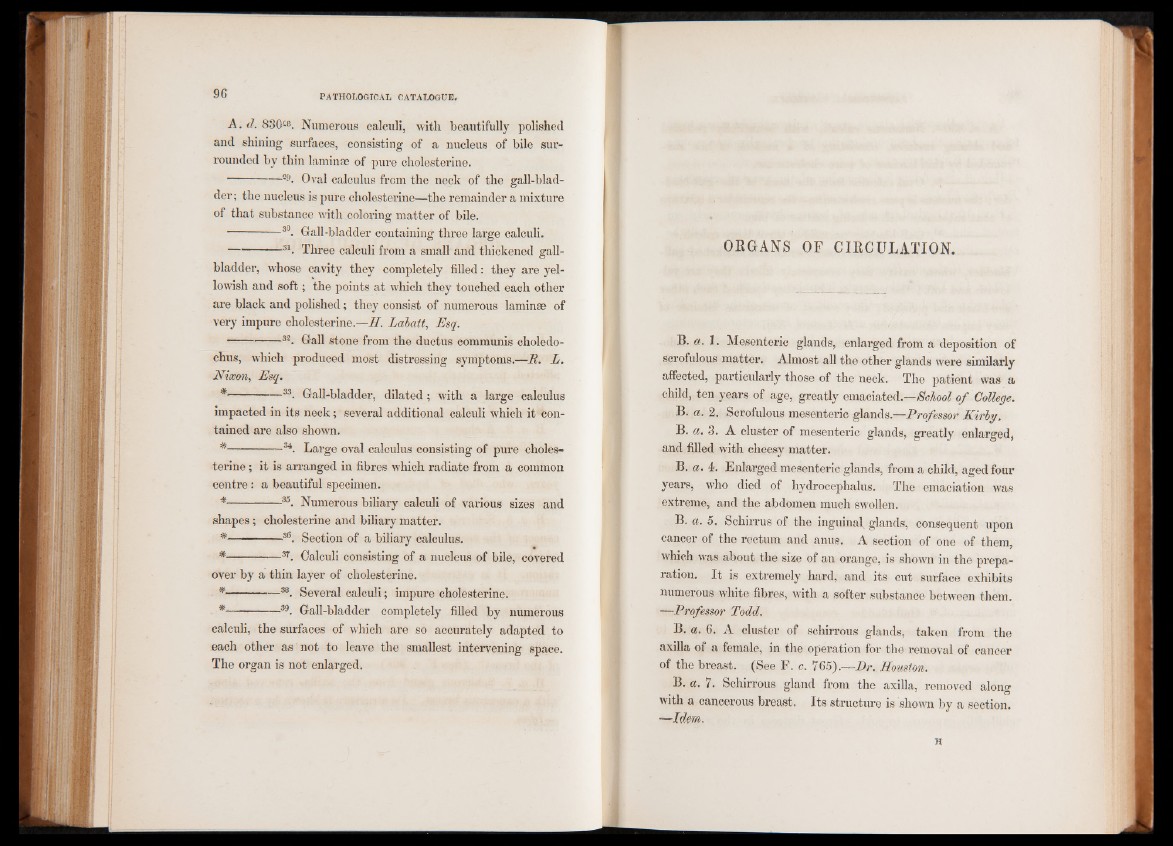
A. <1. 830£8. Numerous calculi, with beautifully polished
and shining surfaces, consisting of a nucleus of bile surrounded
by thin laminae of pure cholesterine.
----------- s&. Oval calculus from the neck of the gall-bladder;
the nucleus is pure cholesterine—the remainder a mixture
of that substance with coloring matter of bile.
----------- 30. Gall-bladder containing three large calculi.
----------- . Three calculi from a small and thickened gallbladder,
whose cavity they completely filled: they are yellowish
and soft; the points at which they touched each other
are black and polished; they consist of numerous laminae of
very impure cholesterine.—-AT. Labatt, Esq.
----------- 32. Gall stone from the ductus communis choledochus,
which produced most distressing symptoms.—R. L.
Nixon, Esq.
*■ —33- Gall-bladder, dilated ; with a large calculus
impacted in its neck; several additional calculi which it contained
are also shown.
* -----------34. Large oval calculus consisting of pure cholesterine
; it is arranged in fibres which radiate from a common
centre: a beautiful specimen.
* ---------3S. Numerous biliary calculi of various sizes and
shapes; cholesterine and biliary matter.
* ---------36. Section of a biliary calculus.
* ---------3T# Calculi consisting of a nucleus of bile, covered
over by a thin layer of cholesterine.
* ---------38. Several calculi; impure cholesterine.
* ---------39. Gall-bladder completely filled by numerous
calculi, the surfaces of which are so accurately adapted to
each other as not to leave the smallest intervening space.
The organ is not enlarged.
ORGANS OF CIRCULATION.
B. a. 1 . Mesenteric glands, enlarged from a deposition of
scrofulous matter. Almost all the other glands were similarly
affected, particularly those of the neck. The patient was a
child, ten years of age, greatly emaciated.—School of College.
B. a. 2. Scrofulous mesenteric glands.—Professor Kirby,
B. a. 3. A cluster of mesenteric glands, greatly enlarged,
and filled with cheesy matter.
B. a. 4. Enlarged mesenteric glands, from a child, aged four
years, who died of hydrocephalus. The emaciation was
extreme, and the abdomen much swollen.
B. a. 5. Schirrus of the inguinal glands, consequent upon
cancer of the rectum and anus. A section of one of them,
which was about the size of an orange, is shown in the preparation.
It is extremely hard, and its cut surface exhibits
numerous white fibres, with a softer substance between them.
—Professor Todd.
B. a. 6. A cluster of schirrous glands, taken from the
axilla of a female, in the operation for the removal of cancer
of the breast. (See F. c. 765).—Dr.. Houston.
B. a. 7. Schirrous gland from the axilla, removed along
with a cancerous breast. Its structure is shown by a section. ’—Idem.
H